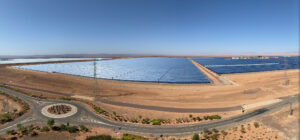
Morocco holds 77% of the world’s total phosphate reserves and is the world’s largest phosphate exporter. The mining sector in Morocco, including copper and silver, represents 10% of Morocco’s GDP, with 90% coming from phosphates.
Most extractive industry sites in Morocco are located in very poor villages where inhabitants are directly exposed to environmental and health risks related to the mining activity.
However, these issues are not covered by the media or taken up by politicians, unlike Morocco’s efforts to invest in renewable energy projects, which have received widespread media attention.
As a climate advocate and a Moroccan, I have a hard time understanding the policy paradox in the Moroccan energy sector. Are we really playing a leading role in facilitating the energy transition on the African continent by investing in renewables? Or are we just hiding the truth about a large extractive industry that’s depleting natural resources at the expense of the health of poor Moroccans?
Grassroots Moroccan communities have come together against government-backed silver mining

In terms of value, silver is the second ranked mineral commodity in Morocco after phosphate. The silver mines of “Société Metallurgique d’Imider” (SMI) are located in Imider village and Igoudrane in southeast Morocco.
The residents of the Berber community of Imider have been speaking out for many years about the toxic waste produced by the mining company. Dozens of villagers have spent the last 9 years camping on a hilltop in the Great Atlas Mountains to protest the disease, livestock fatalities and desertification caused by SMI’s operations.
The villagers, most of whom are farmers, are calling for the company to stop flooding their waterways with toxic waste from cyanide and mercury. They also want SMI—which is part of the ONA multinational controlled by Moroccan royal family—to provide locals with more jobs.

In August 2011, after several months of fruitless negotiations with the company, the villagers decided to take matters into their own hands by shutting off the water flow from the principal reservoir that supplies the mine. In the years since, the villagers have kept up their protest, taking turns camping on Mount Alebban, where the reservoir is located, in the hope that the authorities will one day listen to their demands.
SMI claims that it undertook studies showing that the mine did not damage the environment. However, local activists say that they have never seen such studies.
The Imider protests have created a space for different kinds of struggles to intersect: a struggle for social rights, indigenous rights, and environmental rights. What’s more, the people of Imider specifically emphasize that these different struggles are inseparable within the context of contemporary global capitalism and authoritarian politics.
Why does Morocco continue to invest in the mining industry when it’s already built the largest solar power plant in the world?
Despite Morocco’s position as the second most attractive mining market in the MENA region, the country is known for its reliance on fossil fuel energy, with more than 97% of its energy being imported.

In order to cope with the exponential growth of energy demand, Morocco has constructed a massive solar power plant in the Sahara Desert. The goal of the project is to provide 42% of Morocco’s energy need from renewable sources by 2020 and 52% by 2030. Additionally, the country has increased its investment in renewable energy to reduce its long-term carbon emissions by millions of tons.
This “Green” Strategy was also an opportunity for Morocco to play a key role in accelerating low-carbon transition in the region and attract more investments in the clean energy sector. However, this “sustainability” isn’t benefitting the residents of Imider.
The Moroccan government is clearly still investing in mining industry. Various mining companies cite Morocco’s long mining history, well-developed infrastructure, low sovereign risk, low mining taxation rate of 17.5%, and mining royalty of 3% as attributes that have encouraged them to invest in mining in the country. Foreign company participation in the mineral industry, foreign ownership of mining facilities, and repatriation of profits are all allowed by the Moroccan government.
At the end of the day, it’s the poor communities such as the villagers of Imider, who suffer under Morocco’s policy paradox. They’ve been left behind as the government publicizes its leadership in the energy transition.
The people of the Imider Movement need our support. They represent all of us, and we need to help them defend their social and environmental rights. You can subscribe to their Facebook page and help spread the word.

Thank you for giving this inside into the collateral damages of the Moroccan mining industry. I’m curious to read more about it from your perspective. Are there any plans in the future to reduce the mining or to change the mining technologies in order to be able to run the mines more environment friendly? Best regards Julien
I stand 100% with the people of Imider, but I can’t see any correlation between the investments in green energies and the baning of mining. Green energy can give you power but it can’t provide you with minerals. So there is nothing wrong with thr mining industry as long as it respects the environment and gives-back to the local communities.